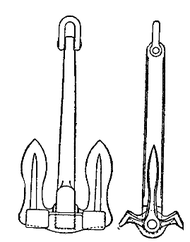whence the words ὀδόντες and dentes are frequently taken for anchors in the Greek and Latin poets. The invention of the teeth is ascribed by Pliny to the Tuscans; but Pausanias gives the credit to Midas, king of Phrygia. Originally there was only one fluke or tooth, whence anchors were called ἑτερὀστομοι; but a second was added, according to Pliny, by Eupalamus, or, according to Strabo, by Anacharsis, the Scythian philosopher. The anchors with two teeth were called ἀμφίβολοι or ἀμφίστομοι, and from ancient monuments appear to have resembled generally those used in modern days, except that the stock is absent from them all. Every ship had several anchors; the largest, corresponding to our sheet anchor, was only used in extreme danger, and was hence peculiarly termed ἱερά or sacra, whence the proverb sacram anchoram solvere, as flying to the last refuge.
 Fig. 1.—Rodger’s Anchor. |
 Fig. 2.—Improved Martin Anchor. |
 |
Fig. 3.—Improved Martin-Adelphi |
Until the beginning of the 19th century anchors were of imperfect manufacture, the means of effecting good and efficient welding being absent and the iron poor, whilst the arms, being straight, generally parted at the crown, when weighing from good holding-ground. A clerk in Plymouth Yard, named Pering, in the early part of that century (1813) introduced curved arms; and after 1852 the Admiralty anchor, under the direction of the Board, was supplied to H.M. ships, followed by Lieutenant (afterwards Captain) Rodger’s anchor (fig. 1). This marked a great departure from the form of previous anchors. The arms, de, df were formed in one piece, and were pivoted at the crown d on a bolt passing through the forked shank ab. The points or pees e, f, to the palms g were blunt. This anchor had an excellent reputation amongst nautical men of that period, and by the committee on anchors, appointed by the admiralty in 1852, it was placed second only to the anchor of Trotman. Later came the self-canting and close-stowing Martin anchor, which, passing through successive improvements, became the improved Martin anchor (fig. 2) made of forged iron. A projection in the centre of the arms works in a recess at the hub of the shank; the vacancies outside the shank are filled by blocks bolted through on each side, and are flush with the side plates, which keep the flukes in position.
The introduction of cast steel in 1894 led to the improved Martin-Adelphi pattern (fig. 3), in which the crown and arms are cast in one, and, with the stock, are made of cast steel, the shank remaining of forged iron. A projection in the crown works in a recess (right, fig. 3), and is secured in its place by a forged steel pin, fitted with a nut and washer, which passes through the crown and the heel of the shank. All the above anchors were provided with a stock (fig. 1, hk), the use of which is to “cant” the anchor. If it falls on the ground, resting on one arm and one stock, when a strain is brought on the cable, the stock cants the anchor, causing the arms to lie at a downward angle to the holding ground; and the pees enter and bury themselves below the surface of the soil.

|
| Fig. 4.—Anchor Crane. |
To stow a stocked anchor on the forecastle, it is hove up close to the forefoot, and by means of a ground chain (secured to a balancing or gravity band on the anchor), which is joined to a catting chain rove through a cat davit, the anchor is hove up horizontally and placed on its bed, where it is secured by chains passing over a rod fitted with a lever for “letting go.” The cat davit is hinged at its base, and can be laid flat on the deck for right ahead fire or when at sea. Ground and catting chains have been superseded in some ships by a wire pendant and cat hook; the anchor is then hove close up to the hawse-pipe. To avoid cutting away a portion of the forecastle, in the “Cressy,” “Terrible” and “Diadem” classes of the British navy, the anchors, secured by chains, are stowed a-cock-bill, outside the ship, with their crowns resting on iron shoes secured to the ship’s side and the flukes fore and aft. A difficulty is experienced in stowing the anchors when the ship is pitching or rolling heavily. Fig. 4 illustrates an anchor with cat davit or anchor crane used in the P. and O. Company’s steamers (“India” class, 8000 tons); for sea the anchor is stowed on board by the anchor crane.
Stockless anchors have been extensively used in the British mercantile marine and in some foreign navies. In 1903 they were adopted generally for the British navy, after extensive anchor trials, begun in 1885. Their advantages are:—handiness combined with a saving of time and labour; absence of davits, anchor-beds and other gear, with a resulting reduction in weight; and a clear forecastle for “right ahead” gun fire or for working ship. On the other hand a larger hawse-pipe is required, and there appears to be a consensus of opinion that a stockless anchor



